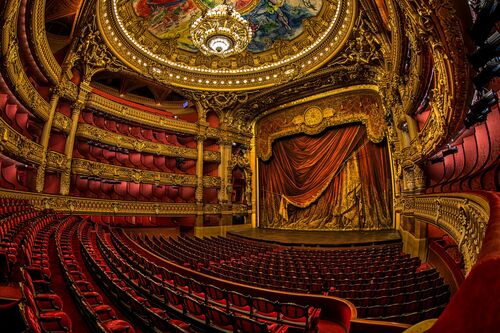How was your passion for photography born?
It was born the first time my older brother came home from a trip to Europe and he made some large prints. He showed them to me, and they were so beautiful and I was just so impressed. I was like, “Wait a minute! You really took these!” It really got me interested, and my brother helped me learn how to use a camera.
Any sources of inspiration among artists?
I love the travel photography of Elia Locardi; the portrait work of Joe McNally; and the aviation photography of Moose Peterson. They are masters at what they do. There are so many artists doing some many interesting things today, like Trey Ratcliff’s fascinating images from the Burning Man festival each year. He takes you to an alternate universe with this images. Same thing with Daniel Choeng’s images of Dubai with the skyscrapers piercing the clouds. They’re so surreal, but at the same time, they’re real.
What attracts you to theatre architecture?
I’ve always been an fan of Theater in general, and I feel there’s something very special about the space these performances take place. You’re surrounded with such beauty from the moment you walk in the door — take a look at the lobby of The Palais Garnier (Paris’ Opera House). The lobby is perhaps even more beautiful than the theatre itself, and the theatre is stunning. The hall that leads to the balcony overlooking the streets of Paris — you could easily mistake it for the Palace of Versailles. The care and craftsmanship that goes into these halls is very special. When you stand in a classic theatre like London’s Royal Albert Hall — you can feel something in the air. This is a special place. This is where magic happens. Where people are brought to tear, or cheer with joy, or leap to their feet. How these venues look matter. They set the stage…for the stage.
What would you like to photograph for your next series?
I’m as drawn to modern architecture as I am to classic architecture, and I’ve been very fortunate to photograph some amazing buildings and venues around the world. Today the architecture of modern museums and libraries really intrigues me and I’ve love to do more of that. Plus, I love having a project that makes me travel. :)
What famous photographs made an impression on you? And which ones do you like at YellowKorner?
Most recently, I fell in love with Annie Lebowitz, after a long time of not being a fan. It was the Princess series she did for Disney - it was just amazing, and suddenly the light came on for me and her work, and once it did I went crazy for the group portraits she does, in particular he group shots for Vanity Fair. I don’t think there’s anyone out there doing them better. Here on YellowKorner, there are so many talented, gifted artists. I love the scenes of Paris from French photographer Serge Ramelli. His use of color really makes the city come alive. I also enjoy the work of another French artist - Laurent Dequick - such a great sense of movement and excitement. Really wonderful and different. Argentinian photographer Romina Ressia has a old masters portrait series that I love, and though I don’t classify myself as a fan of wildlife photography, Klaus Tiedge could make me change my mind. Wow! The amount of talent her is very humbling.
How would you describe your work in a few words?
I want my viewer to feel like they are sharing a quiet moment, in a special place.
How important is postproduction in your photography? (Discuss your retouching expertise)
As Editor-in-Chief and Publisher of Photoshop User magazine, I think post production is simply another part of the process, just as Ansel Adams did with this marvelous work. I have my own personal code of ethics when it comes to post processing — I want to use Photoshop to bring out the things my camera captured but are lost in the capture process. I don’t like to add things that are not there — I don’t like to swap out for a better sky, or put people into a scene who weren’t there. In fact, for my post-processing I’m likely to remove something distracting, but very unlikely to add something to make the image more interesting. I’m in my “less is more” stage when it comes to post processing. I don’t like my amp on 11.
Which location did you most enjoy taking photographs of? Why?
I so love Paris. There is just no place else quite like it on earth. I’ve been there a dozen times, but it’s the one city where I feel like I haven’t even scratched the surface. There’s a new story, and an amazing meal, and a new adventure around every corner.
How do you select your shooting sites?
I often travel to a city to shoot a particular building or cathedral or landmark, but many times I’m simply on holiday with my wonderful family, who are incredibly supportive of my photography. Each year I host a Worldwide Photo Walk (for 11 years now this year), and over 1,000 cities around the world participate (with 100% of the proceeds going to the Springs of Hope Orphanage in Nakuru, Kenya), and each year I get to choose a new place to photograph. This year I’m hoping it will be in Morocco, in the city of Fez. Then after hosting the walk, off to the Blue City and a few nights in the Sahara. I am just so excited.
Anecdotes for your series of photographs?
“One of the things I wanted to do with this series is to make each image as timeless as possible, in regard to when the photograph was taken. I wanted to take away as many hints as to a time frame as possible, and for the most part that meant getting special permission to photograph the space while empty, either before or after hours (my preference was always in the morning, so I could shoot in beautiful, natural light. The clothing and hair styles of visitors in the space would often give away the time frame, so shooting without any visitors or tourists visible, any time that was possible, was a big factor in achieving the timeless look.”
Which message do you want to convey through your photographs?
I want the viewer to experience these epic venues as they looked when they first opened, but to view them with the vibrant colors, detail and dimension that today’s incredible cameras can capture. I want them to be taken away to another time and imagine the thrill of opening night, or the quiet stillness of a monastery library, or the bustling of a classic rail station in its heyday, while using today’s tools and artistic vision to reveal themselves in a way they perhaps never have before.
When did you start practicing photography? What is your professional background?
I started in the early 1980s as a travel and portrait photographer with a studio based in Central Florida in the USA, but it was my transformation to digital photography in the mid 1990s that reignited my passion for photography. Today, I travel the world photographing some of the most captivating locations and exotic locales. I also do assignment work for a sports news wire, covering professional sporting events, and I shoot fashion/beauty along with my personal work of photographing beautiful automobiles.





